Houston Dash were worthy winners of the recent NWSL Challenge Cup with their counter-attacking style which saw them pose a mixture of a solid defensive structure along with an effective attacking intent. The Dash have been supremely effective and impressive throughout the tournament which resulted in the most goals. Scoring eight goals with an expected goals value of 6.75, Dash executed their attacking plans successfully.
In this scout report, we will look at James Clarkson’s main tactical concepts that contributed towards their successful attacking tactics. To truly understand the success behind their attacking play, this tactical analysis will look back at the 2019 NWSL season to see where improvements have been made.
Houston Dash’s build-up structure
For us to better understand this analysis, we will need to understand how the 2020 system works, which will be broken down into several sections. A significant contributing factor has been the change in formation and system. Clarkson ran two active formations in 2019, in the 4-2-3-1 (60%) and 4-1-4-1 (40%) which has now become a 4-1-4-1 (83%) and 4-3-2-1 (10%). While there is heavy use of one system, Dash integrates both formations within a game which proved to be very successful. Coupled with their defensive base, the team was able to effectively counter-attack, having enough players in both the attacking and defensive thirds.
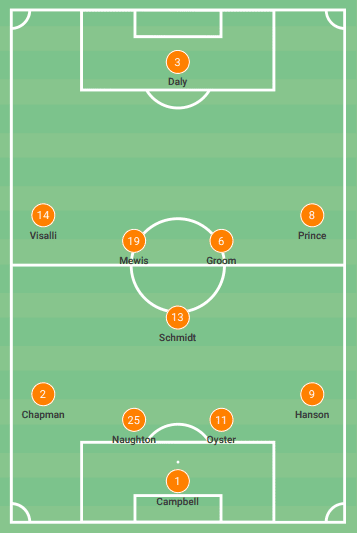
Houston Dash have a couple of ways to build out from the back but these variations are carried out to produce similar results. In essence, Clarkson wants his team to move from back to front efficiently and quickly with these routines making the team unpredictable and give them options to negate the opposition’s strengths in different areas of the pitch.
When building out from the back, their main build-up method comes from the central defenders. The centre-backs will play quick passes between the back four and defensive midfielder and look for an opening especially against teams that look to employ a high man-marking press. They recycle possession through short passes to eventually create an opening for one of the centre-backs to drive through the middle and play a pass into the striker. This again helps to create space further up the pitch by forcing teams to press the centre-back when the opposing midfielders need to commit to stopping the defender. Once in midfield, the centre-back will play a pass into the centre-forward who in turn will look wide for the overlapping player. After which the ball will eventually make its way back into the central areas as they get closer to the opposition’s 18-yard box.
Though, their best and most effective option to build-up from are direct diagonal passes into the wide players from the defenders. The centre-backs play long diagonals into the wide players, which is often used to catch teams off guard or when opposing teams press Dash high. If the opposition full-back is caught high, then Katie Naughton or Megan Oyster will look to play these passes quicker.
The single pivot will be positioned just behind the opposition’s first line of pressure but will drop in to give the centre-backs an extra passing option as a result of the opposition’s press. The more attack-minded central midfielders will then take up positions between the opposition’s first and second line of pressure to receive possession from the second balls once the ball has been played up field and the opposition has pressed up.
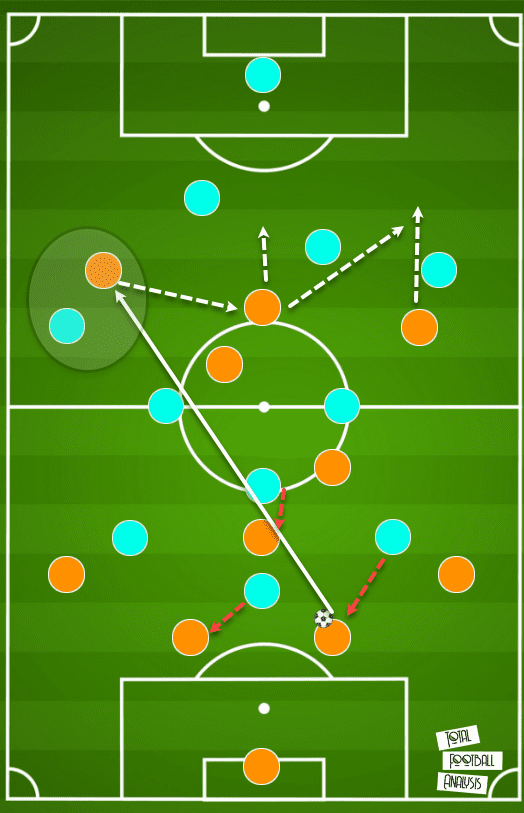
When the ball reaches the wide player, she will look to find Rachel Daly or Shea Groom, who more often than not will be in and around the ball receiver to link play. The pass from the wide player to the striker is important as it gives Dash an opportunity to either progress centrally or play it out wide. This makes them unpredictable and gives them a chance to progress in a way that allows them more space to attack. This theoretical representation of the aforementioned build-up structure shows how the Dash can bypass the opposition’s press and take advantage of the spaces created as a result.
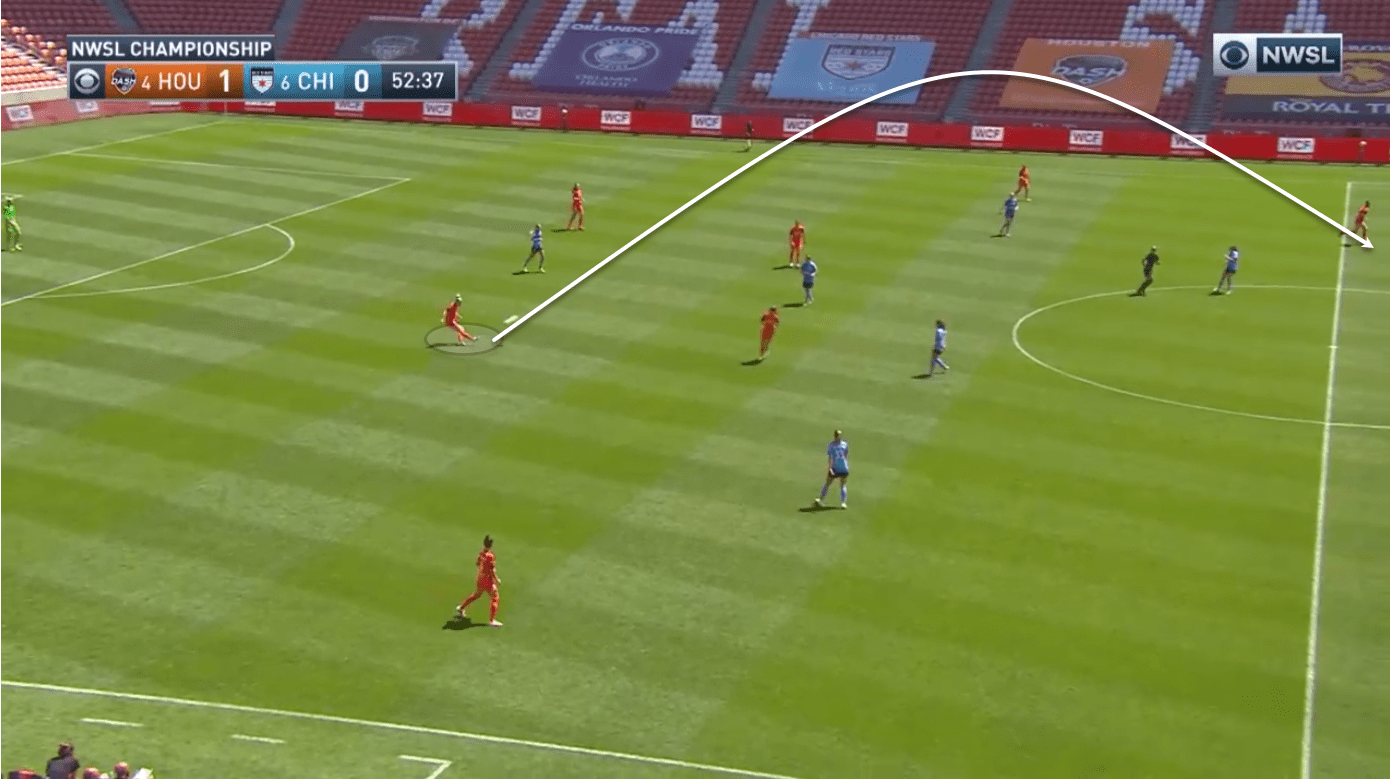
If we look at this passage of play from the recent NWSL Challenge Cup final, we can see Chicago Red Stars not pressing Dash’s centre-backs very tightly, though the team has pushed up. This triggers Oyster to opt for the long diagonal pass. Both Sophie Schmidt and Groom both drop as they see Red Stars commit more players to the press.
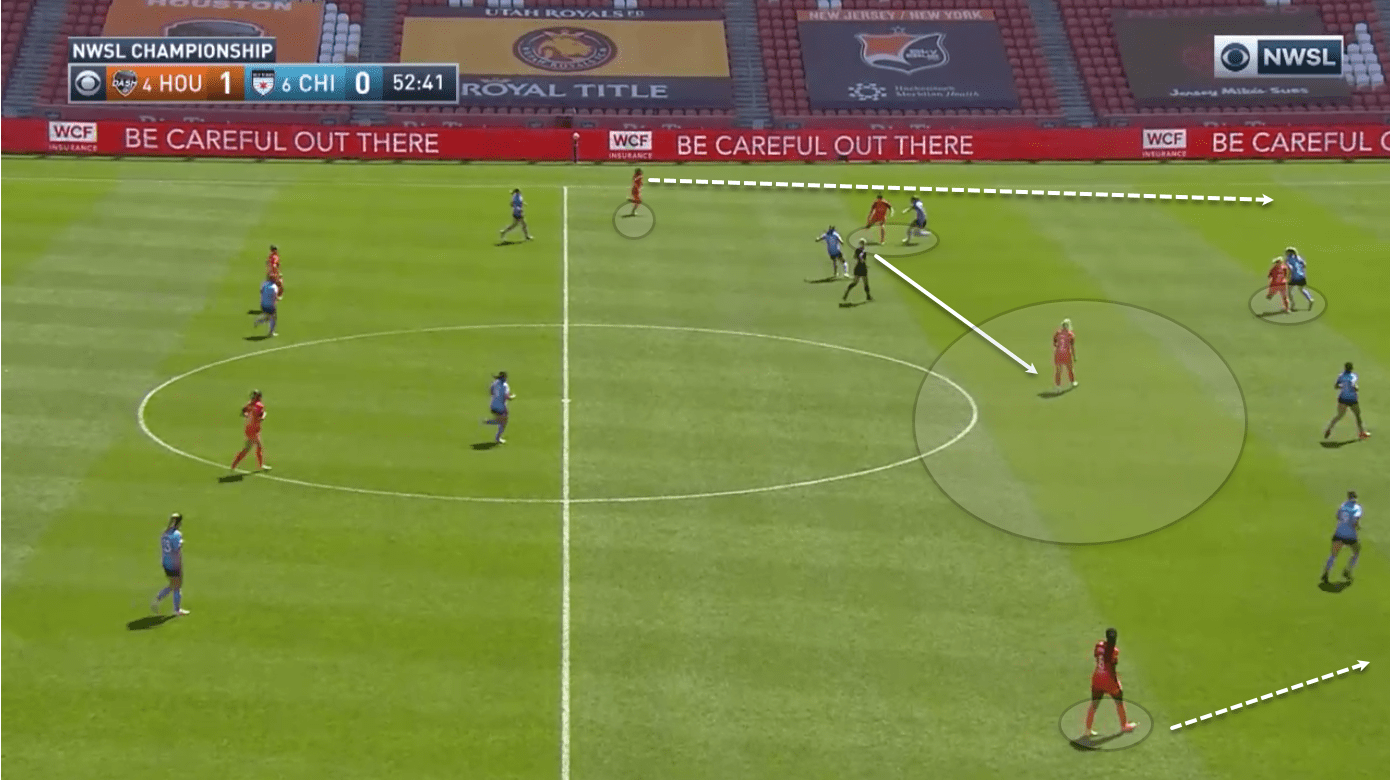
The ball is collected by a Dash player in the half-space with a player on the overlap and the centre-forward, Daly, inside. Daly dropping into midfield means she is not marked and Red Stars midfielders are too high and focused on the wide ball receiver.
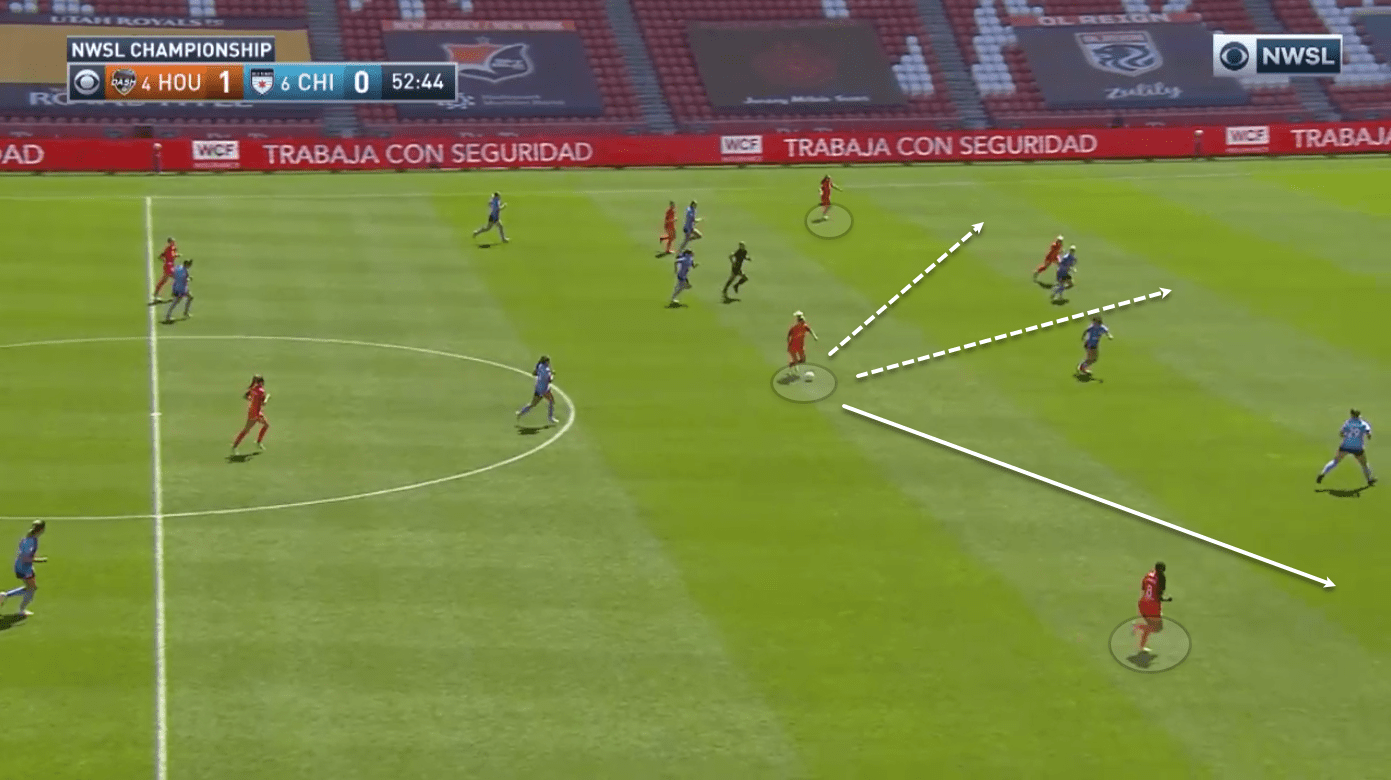
In this position, Dash can now attack in a 4 vs 3 position with Daly having the choice of playing to her left or right and stretch the opposition backline. The ball will go wide right to Prince forcing Red Stars to shift right and allow Dash to overload.
Midfield progression
At a glance, the main tactics need to create a solid defensive base with a view to hitting teams on the counter-attack with fast, agile, and direct movements forward through their central and wide attacking midfielders with the centre-forward being the main glue. Their build-up structure is set up to progress the ball directly from defence to midfield and attack. The system allows the Dash to utilise their key players better and allow for greater verticality than in their previous setup.
One of the main advantages of the 4-1-4-1 / 4-3-2-1 system is the distance between the lines are much smaller which allows for better link-up play and connections with key players. In this case, Daly’s false nine role is one that sees her drop into pockets of space, sometimes deep into central midfield to collect possession and distribute it further forward. Earlier, she would collect possession deep but there were either no willing runners or players were outnumbered. Daly makes up an extra body whenever her team needs a passing option and can do this freely knowing there are numbers in attack to fill in the gap.
This shape allows her to drop but also ensures there are enough players to capitalise on the vacant space she leaves behind. However, while this does open up more opportunities for the centre-forward to move into pockets of space, one of the most important players to the success of this system are the wide midfielders playing as the left and right-midfield pairing.
The 4-1-4-1 morphed into a 4-3-2-1 with the two wide players playing inverted roles occupying the half-spaces with the two ‘8s’ pushing into attacking midfield positions playing as faux ‘10s’ which changed their system. This essentially creates a very flexible system. The defensive midfielder is the only player to remain positionally disciplined to shield and protect the back four. Off the ball, Dash moved into a 4-3-3 to stop the opposition full-backs from bombing forward and it ensured that when possession was turned over those full-backs had to be mindful of the combination play between the central and wide midfielders. It also acts as a way to attack with the two wide players moving more narrow as they progress up the field.
Once they reach the final third, the two ‘wide players’ in Brianna Visalli and Nichelle Price will push into the half-space creating width with the full-backs overlapping to support if the opportunity presents itself. So when the centre-forward drops deep and one of the attacking midfielders pushes forward, the two centre-backs are pulled away with the full-back moving inside to cover the vacant space. This allows the inverted wide players to push forward into the half-space almost unopposed. The below graphic depicts some of these main attacking movements.
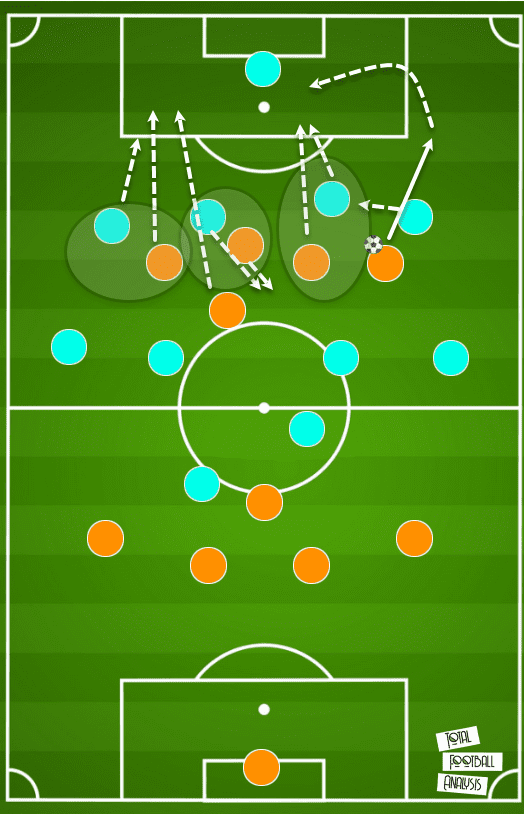
There are two ways these midfielders will progress the ball. One, by driving into the half-space after the centre-forward has started an attacking move in midfield, which creates a diversion and focus on one side and allows for a quick switch or cross into the box. This is something we saw in the earlier example in the build-up phase where the wide midfielder will pick up possession in the half-space and look to cross.
Second, though much less frequent is by mirroring the earlier move but playing the ball wider towards the overlapping full-back and making their way into the box to ensure numerical superiority. The full-backs tend to stay in midfield in line with the ‘6’ as their strengths lie in defending rather than attacking. This also helps to ensure that the Dash have enough defensive cover against any counter-attacks.
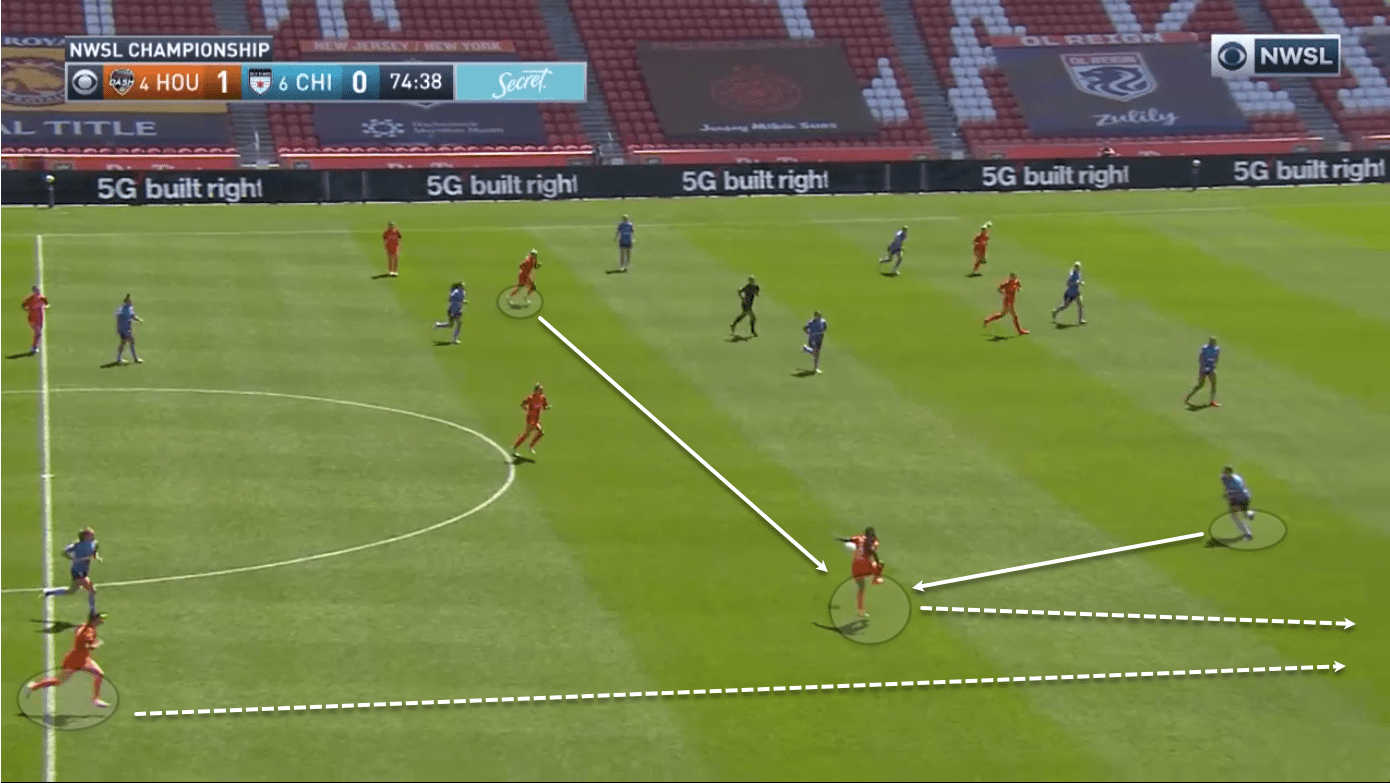
Here Daly looks to switch play from left to right by playing a long pass towards Prince who is positioned in between the lines of midfield unmarked. Dash’s right-back understands the opportunity to push forward and take advantage of the space down the flank especially with the full-back looking to press Prince.
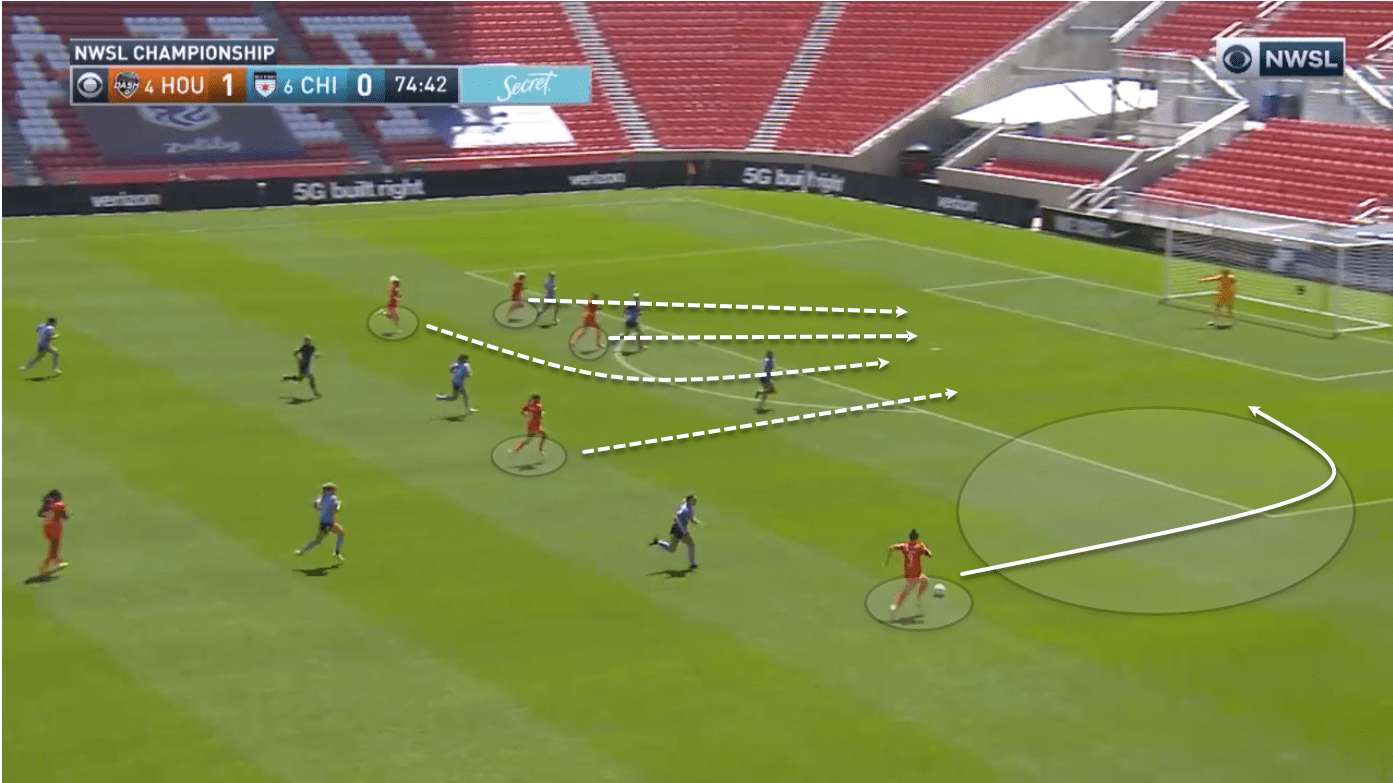
The resulting move sees the full-back in acres of space to cross the ball into the box allowing Dash to get more bodies into the box to receive the final pass. Though the system is clear, Clarkson has allowed some degree of autonomy to the full-backs especially to push forward if the opportunity presents itself.
The problem in 2019 was the lack of link-up between midfield and attack. The attacking and midfield lines were separated and a lot of isolated battles occurred in the final third. In using the 4-2-3-1, the two wide players were more inside-forwards looking to cut inside and take on the opposition full-back with the full-backs assisting them at times.
Because of the direct build-up, passes were played into the wide areas with not enough players making forward runs into the box, this often left the ball-carrier isolated in 1 vs 1 battles against the full-back which gave enough time for the central defenders to mark the centre-forward and any other player present.
The central midfielders were more static, with one pushing up slightly more than others. This was especially because of the double-pivot pairing which required them to stay a bit deeper with Kristie Mewis playing a hybrid playmaker/holding role. This meant she was restricted in pushing forward as much as she does now. The next section will focus on Mewis and the other ‘8s’ movements. Both systems revolve around counter-attacking and holding a compact defensive shape, but the changes in 2020 have allowed Dash to become more flexible in the final third.
Penetration through the ‘8s’
Now that we’ve been able to identify Dash’s build-up through their wide midfielders, we will now look further forward and see how the addition of two attacking central midfielders has benefited both the wide players and centre-forward.
Arguably, one of the most important changes in the team have been the attacking midfielders. Clarkson’s move to play two attacking ‘8s’ has proved to be an excellent move as it has allowed the Dash to assume much more control over spaces in the final third. A lot of the problems in 2019 stemmed from having a double-pivot that was too static and defensive which caused there to be too much space between the lines.
Mewis assumed the role of both playmaker and box-to-box midfielder when her strengths clearly lie in her passing and space creation. The addition of Groom was pivotal as the Dash could leverage her dribbling ability to not only help progress play but create space through direct running. They made sure to have enough numbers behind their centre-forward to not only encourage more link-up play and space creation but to be able to have numbers in the box.
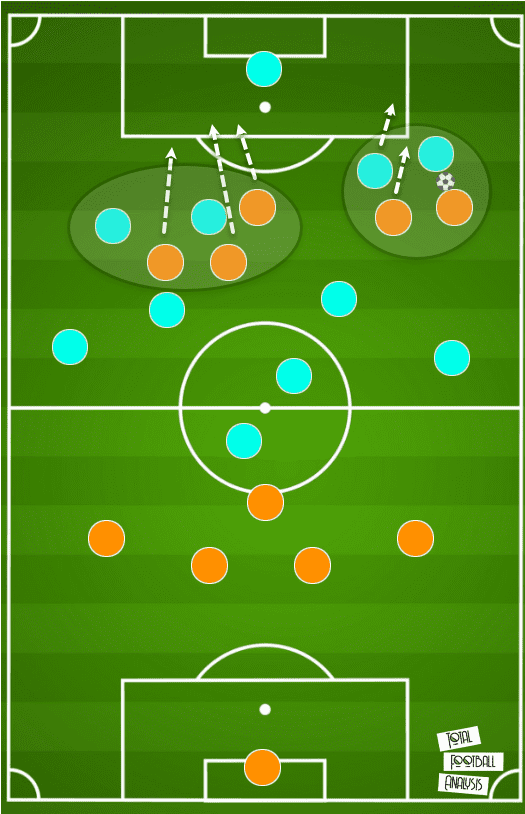
The above graphic is a representation of what Clarkson was trying to achieve with his team. We can see the wide player on the ball up against the opposition full-back with midfield players drifting across. One of the central midfielders will come across to support the wide player and bring much of the attention to this side. The idea is to cross the ball into the remaining players in and around the box to win aerial duels and/or second balls.
Part of the tactics here is to ensure that Dash have numerical superiority and focus on one side of the pitch to be able to switch play quickly and have enough numbers in the 18-yard box. Even though the system changes between a 4-3-3 and 4-1-4-1 within the game, the basic principle of having two players behind the centre-forward remains. When Houston Dash are in possession, they want to ensure the opposition is focused on one side by committing players across allowing the players on the opposite side to make late runs into the box. The late runs of the opposite central midfielder, wide player, and centre-forward will be in a perfect position to overload the box.
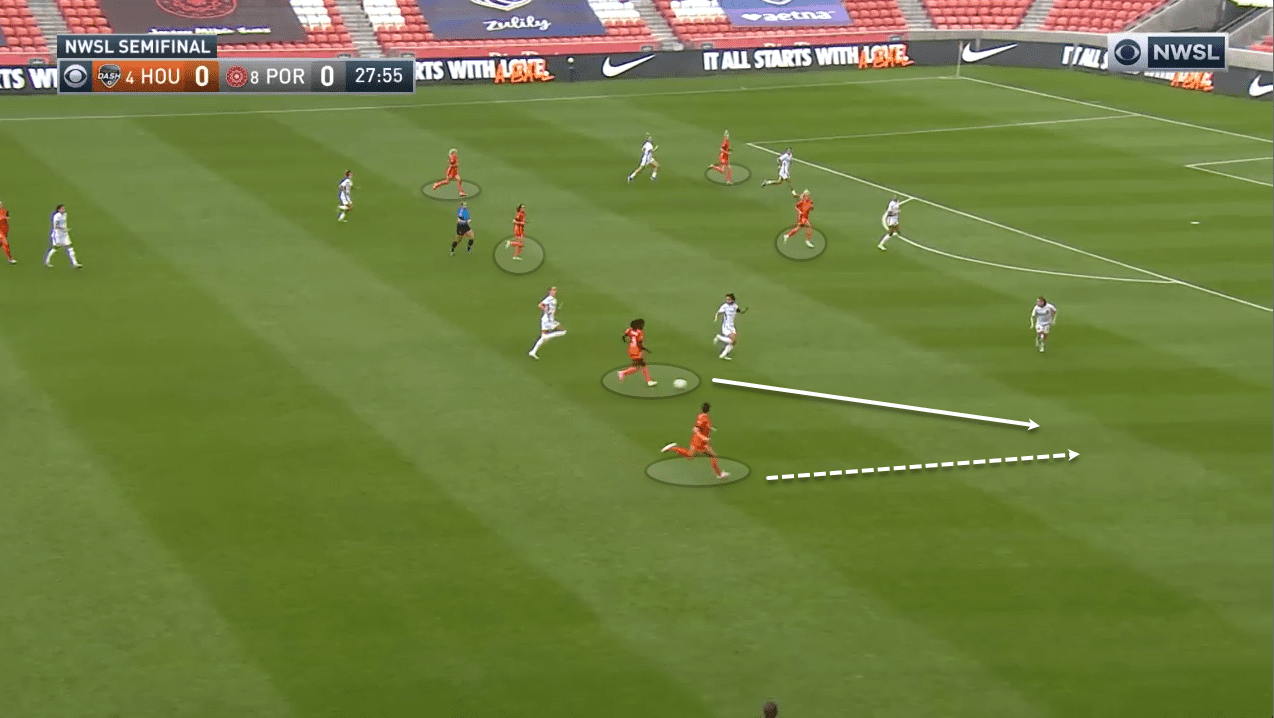
This attacking move against Portland Thorns shows us this sort of move. We can see Prince driving through the half-spaces with a rare overlapping full-back. We can see four Houston Dash players on the left side of the pitch including Groom and Mewis. This run has taken the attention of three Portland players breaking up the defence into two parts.
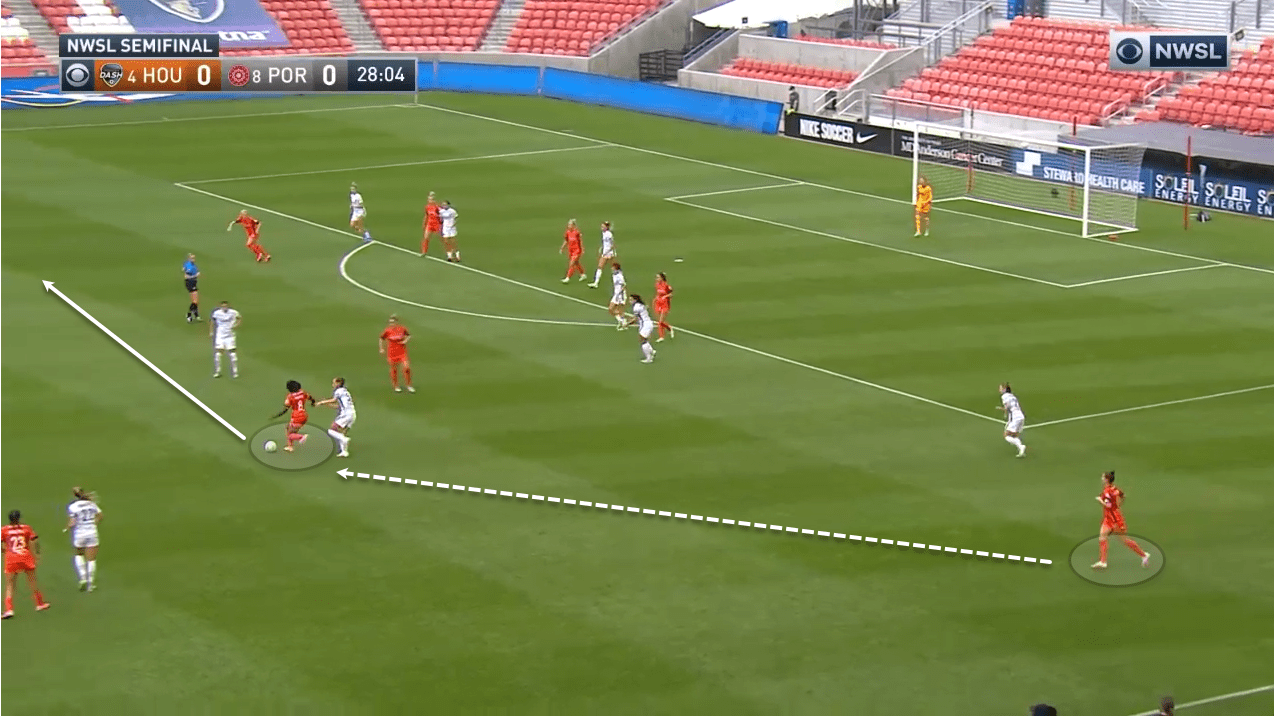
The ball is passed back to Prince who looks to switch play to the left, but what we can see already is that Houston Dash have 3-4 players in and around the box. As the ball is played out to the left, Groom and Daly make runs across to the far post thus creating a gap between Portland’s defence.
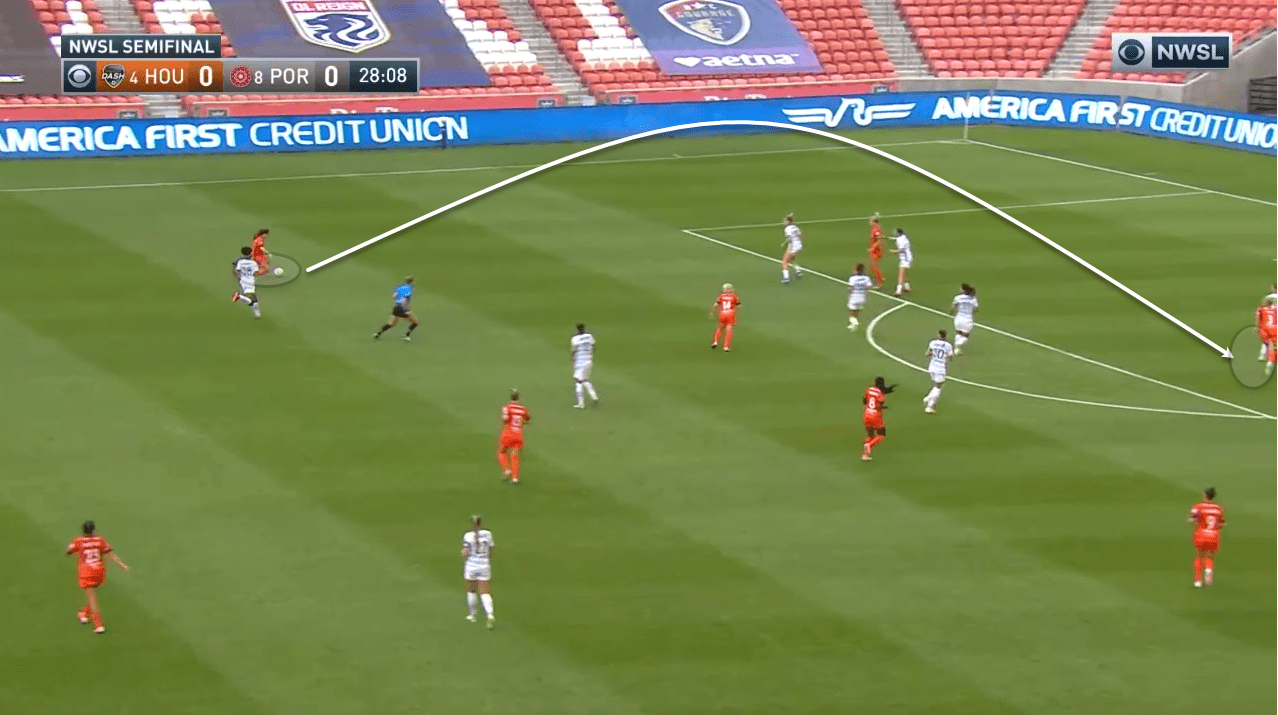
Now there is a lot of space for the onrushing player to time her cross well. More interestingly, we can see how Daly and Groom (out of frame next to Daly) are now engaged in 1 vs 1 duels with both centre-backs, leaving a gap for the late runs of Prince and Brianna Visalli. A lot of these crosses are intended for Daly to head towards goal or lay off for a nearby player. In this case, the cross was overhit but the tactical concept was on display.
The main takeaway has been better attacking organisation and cohesion between the Dash attackers. The deeply positioned full-backs has allowed Dash to commit more players forward separating the teams into five and five. Five players committed to defending and five players committed to attacking, which gives Dash a number of attacking options going forward.
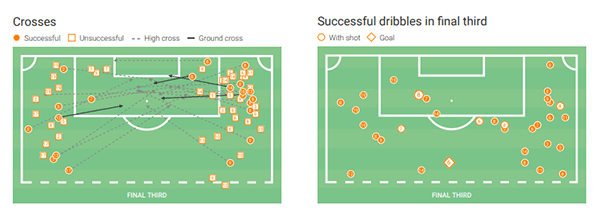
These two graphics depict Houston Dash’s work on the ball and supports the notion of where they focus their attacks. If we look at the dribbles across the NWSL Challenge Cup, we can see a high proportion of them in the wide and half-spaces, with a rare number coming from the middle. This coincides with their high volume of crosses and more specifically the frequency of high crosses, especially off the right, as we’ve seen Prince do in the earlier example. She’s been directly responsible for 18 crosses and 14 dribbles which has shown how vital Prince is to the team’s attacking exploits.
Final Remarks
These tactics, though not the most glamorous, are very effective, so much so that Houston Dash won the NWSL Challenge Cup. A mixture of new personnel and some innovative tactical changes from Clarkson has his side playing to their strengths. The team is now playing a more role based system that relies less on individual players all across the team. Though their spine players in Daly, Groom, Mewis, and Oyster have been pivotal to their success and enabled Dash to perform at their very best.
This counter-attacking and defensively solid style of play is reminiscent of Jose Mourinho’s Inter Milan or Diego Simeone’s Atletico Madrid. Both teams have won domestic and continental titles playing a counter-attacking style of football in spite of other teams considered favourites. The performances of their players could attract interest from leagues across Europe, no less than the FAWSL where we’ve already seen a number of high-profile loan moves take place already.



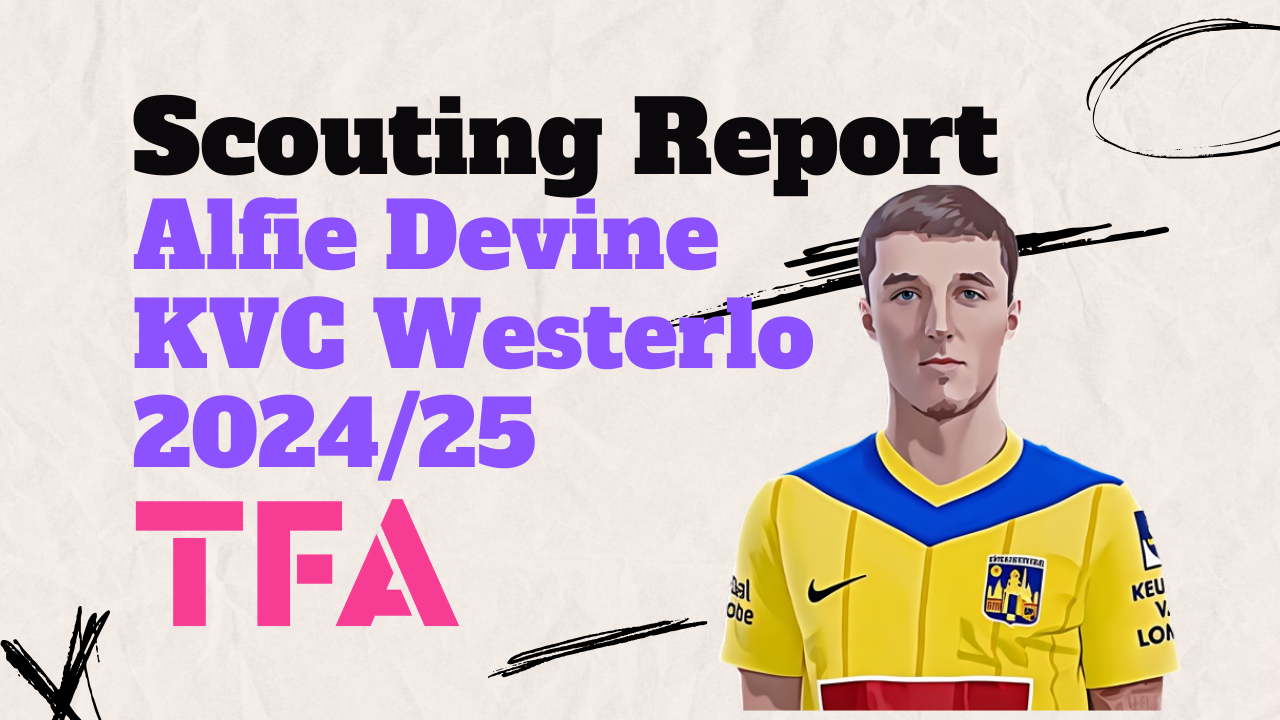
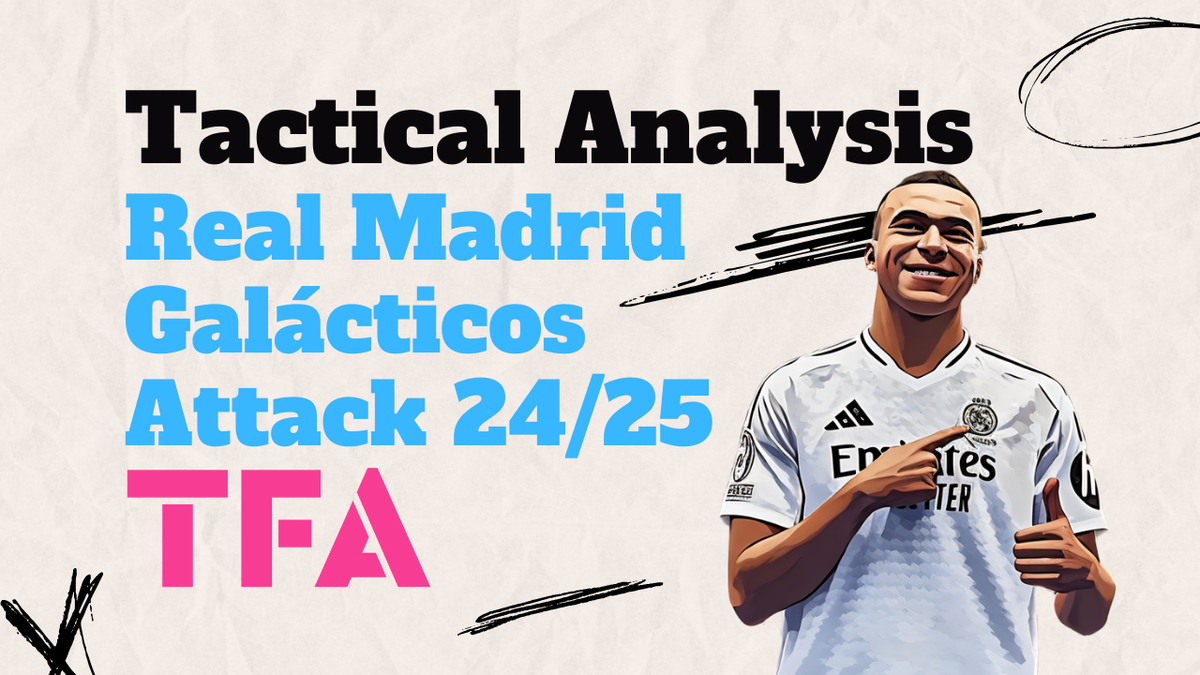
Comments